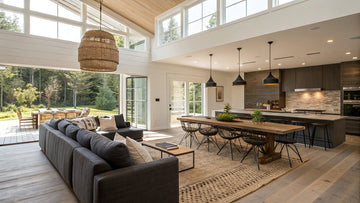Splitting up open spaces works best when using several simple tricks together. Room dividers that can move, different types of lights, and smart furniture placement help create separate areas while keeping the space feeling open. Using different floor materials, fabrics, and tall storage units makes clear borders between areas without putting up walls. Adding different colors to mark spaces and choosing items that serve multiple needs helps spaces feel more divided. These basic methods give you many ways to organize your open space well.
Key Takeaways
- Use movable screens and room dividers to create flexible boundaries while maintaining an open feel and natural light flow.
- Position furniture strategically to form distinct areas, with seating clusters and back-to-back sofas naturally dividing spaces.
- Define zones through contrasting flooring materials and area rugs that visually separate different functional spaces.
- Implement varied lighting schemes to distinguish activity areas, using bright lights for tasks and softer lighting for relaxation.
- Install tall storage units and shelving as practical space dividers that maintain openness while providing functional storage solutions.
Flexible Room Dividers and Decorative Screens
Room dividers and screens are key tools when setting up open spaces, helping create separate areas while keeping the space feeling connected. These useful pieces let you change your layout whenever needed, making the most of modern open homes.
Today's screens look good while serving a clear purpose, using light materials that make them easy to move around. Whether you choose wooden panels, glass dividers, or fabric screens, they let light pass through to keep spaces bright and open while marking clear spaces for different activities.
Many dividers come in pieces you can fit together, and some even help block noise - perfect for creating quiet work areas in busy homes. Smart use of these dividers makes open spaces both more useful and better looking.
Strategic Lighting and Color Zoning
Homeowners looking to split up their open spaces can use smart lighting and colors to create separate areas without walls. Using different light levels helps mark out spaces - bright lights work well for tasks, while soft lighting creates cozy spots for eating or unwinding.
Using different colors also helps show where one area ends and another begins. Warm colors like reds and oranges make social spaces feel friendly and welcoming, while cool colors like blues and greens help people stay focused in work areas.
When lighting and colors work together, people can easily move between different areas while the space still feels open and connected. This approach keeps the room feeling spacious while showing clear zones for different activities.
Furniture Placement and Layout Techniques
The right placement of furniture helps create different areas within open spaces. By carefully placing furniture pieces, you can make separate spaces that work well together while keeping each area distinct. Good furniture arrangement helps people move easily between areas, with pieces like sofas working as natural dividers. For optimal results, consider lounge furniture arrangement principles when planning your layout.
| Element | Function |
|---|---|
| Seating Clusters | Creates cozy talking spaces |
| Back-to-Back Sofas | Splits rooms naturally |
| Modular Furniture | Adapts to changing needs |
| Storage Ottomans | Works as both seating and storage |
| Area Rugs | Defines separate spaces |
Furniture that serves multiple purposes helps make the most of available space while keeping the open feel of the room. Using furniture of different sizes and shapes helps each area serve its purpose while making the whole space look and work better together. Explore multifunctional furniture solutions to maximize your space efficiency.
Flooring and Textile Boundaries
Different types of flooring help create natural dividing lines between areas in open spaces. Using different floor materials - like changing from tile to wood - helps show where one space ends and another begins, while keeping the whole area easy to move through. Rugs are key in marking off different spaces and helping furniture groups look more connected. Big rugs with patterns work well to separate areas for different uses, while also making the space look more interesting and cozy.
Using different floor materials alongside carefully placed rugs makes the change between spaces feel smooth. Other soft items like curtains and blankets add more layers to these divisions, using colors and patterns to show what each area is meant for.
Vertical Elements and Storage Solutions
Tall storage pieces work well to divide open spaces while keeping them bright and useful. Built-to-fit shelves and tall bookcases create good boundaries between areas while letting light flow through, plus they offer plenty of space to store everyday items. Consider contemporary shelving solutions for both storage and visual division.
Storage units that reach the ceiling, like hanging dividers and open shelves, make rooms feel bigger while creating separate areas within big spaces.
Furniture that serves multiple purposes fits well into these layouts - like desks with built-in shelves or storage footstools that both store items and mark different zones. Learn more about storage footstools as solutions for open-plan areas.
Placing tall items carefully, from big shelving units to rows of plants, adds visual appeal while keeping the open feeling of the space. These smart storage choices help create a tidy, good-looking space that strikes the right balance between separate areas and connected spaces.
Multi-functional Features for Space Definition
Smart features that serve multiple purposes help create different areas in open spaces. Simple but clever furniture, like adjustable sofas and built-in seating, helps split rooms while keeping them easy to change.
Kitchen counters that stick out into the room naturally split cooking spaces from eating areas, working both for food prep and casual meals.
See-through bookshelves can split rooms while letting light pass through and showing off books and decorations. Rugs help group furniture together and mark different activity spaces without putting up walls. Different types of lights also help separate areas - hanging lamps over dining tables and desk lamps for work spaces.
All these pieces work together to create clear areas within open rooms while keeping the space flowing smoothly.
Frequently Asked Questions
How to Create Zones in Open-Plan Living?
Simple furniture placement, matching colors, and floor rugs create separate spaces, while different lights, room dividers, artwork, plants, and mixed materials help split up and improve each living area naturally.
Why Are People Going off Open-Plan Living?
People are moving away from open-plan homes because they need more privacy, want less noise, and find it hard to keep spaces tidy. Living in one big room makes it tough for family members to do different things at once, like watching TV while someone else studies. Many now prefer separate rooms that give them quiet space and let everyone enjoy their own activities.
How to Define Spaces in an Open Floor Plan?
Using furniture in smart ways, different types of lights, and well-placed rugs help split up open spaces. Matching colors, room dividers, pictures on walls, and useful furniture create separate areas while keeping the space easy to move through.
How to Separate Areas in an Open Floor Plan?
Room dividing is easy with smart furniture setup and rugs to mark different areas. Screens and bookcases help split spaces, while different paint colors, well-placed lights, and indoor plants help create clear zones in open rooms.
Conclusion
Creating distinct zones in open-plan spaces becomes simple with strategic furniture placement from Timbur. By using carefully chosen pieces and smart design elements, open areas transform into functional zones while keeping the space connected. Custom furniture, proper lighting, and well-placed dividers help mark different activity areas naturally. These thoughtful boundaries let the space flow freely while giving each section its own clear purpose for everyday living. For compact areas, explore space-saving solutions to make the most of your open-plan layout.









